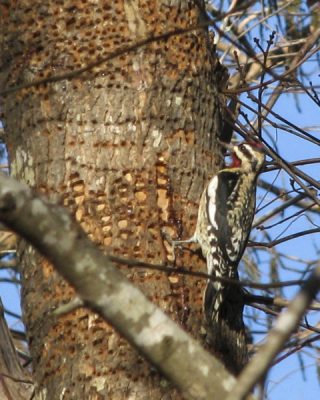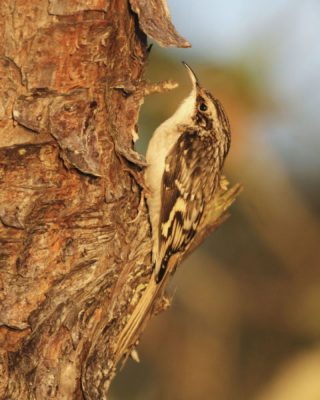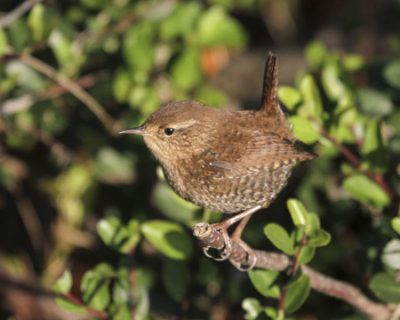Reprinted from The Outer Banks Voice. Each month Jeff Lewis, an expert on birds and bird-watching, writes an article on the subject for the publication.

Cool November temperatures and chilly north winds send us our winter birds.
Supporter Spotlight
In wooded habitats, and along the edges, look and listen for yellow-bellied sapsucker, eastern phoebe, blue-headed vireo, brown creeper, winter wren, golden-crown kinglet, ruby-crown kinglet and hermit thrush.
Some of these species are easily overlooked, so let’s look closely at three of them, a trio that nests in the North Carolina mountains.
Yellow-bellied sapsuckers are fairly common here in winter but are easy to overlook. These woodpeckers can be heard drilling into trees or mewing, similar to a catbird, but if you approach too hastily they move around to the back side of the tree, remaining hidden. Stand still for a minute, and they’ll usually show themselves again.
As their name implies, sapsuckers feed on tree sap, and this is the reason for the drilling, of course. Interestingly, a sapsucker will drill various sizes and patterns of holes, depending upon the species of tree. They will peck deep holes, shallow holes, holes in horizontal rows, holes in vertical rows, tightly spaced or distant holes, round holes, oval holes or even shallow flat squares, small or large.
It is incredible how these unique birds have learned how best to harvest the sap from each tree. After the hard work is complete, sapsuckers return periodically to harvest the sap that has collected, which they lick up with their tongue. The insects that get stuck in the sweet sap add a little protein. Sometimes hummingbirds and other species will steal a little of the sap when the sapsucker is not watching. In addition to tree sap, sapsuckers also feed on berries and insects.
Supporter Spotlight
Brown creepers are a bizarre little bird. Brown above and white below, and only about 5.5 inches long, a brown creeper looks a little bit like a Carolina wren, except with a stiff woodpecker tail. Their feeding behavior is unique.
Brown creepers start at the base of a tree, usually a large one, and using their stiff tail and down-curved bill for support, creep up the tree in a spiral searching for insects and spiders in the cracks and crevices of the bark. When they reach the top, they simply flutter down to the base of the next tree and start all over again. They remind me of a mouse or a large bug, flat against the trunk.

Brown creepers are very cryptically patterned and are easily overlooked against the brown bark. Even the calls that creepers give are hard to hear, as they are extremely high pitched. Many people cannot hear them at all. So fixated on tree trunks, brown creepers even build their nests, similar to a hammock, under a wedge of bark.
Winter wrens have one of the prettiest songs of any bird, in my opinion, a long, bubbly concoction of about 100 separate notes, but you’re very unlikely to hear one during the winter on the Outer Banks.
They will sometimes sing in spring just before leaving for their breeding grounds, though. Winter wrens are dark brown and tiny, only about 4 inches long, or about the size of a chicken egg, with a head and stubby tail attached. They prefer dense tangles in woods, often in moist habitats, and forage for insects along the ground.
They are considered secretive and hard to see, but mostly, if you sit still for a while, they just ignore humans; I’ve actually had one hop right over my feet. Once you learn the two-note call that they give, a hard “jip-jip,” they become easier to find.
Winter wrens have a peculiar habit of bobbing up and down and they have a very short tail that they keep stuck straight up, so they are easily identified, once found. They mostly forage along the ground for their insect prey.
Other winter resident songbirds that are present by November include orange-crowned warbler, palm warbler, and a good variety of sparrows: Savannah sparrows, song sparrows, swamp sparrows and fox sparrows are four common to uncommon ones. white-throated sparrows and chipping sparrows are common in some of our yards and some years we have good numbers of dark-eyed juncos. Nelson’s and saltmarsh sparrows can be found by trudging through brackish and salt marshes. Unusual to rare sparrows to look for in winter include Lincoln’s, vesper, lark and tree sparrow, to name a few.
By November we are inundated with yellow-rumped warblers, aka butter-butts, so named for their bright yellow rumps. These little birds are found in abundance and in a great variety of habitats; just about anywhere there are some shrubs or trees for a little cover.
Waterfowl are mostly in place by November, especially by the end of the month.

Get out early and scan the pond at Bodie Island and especially the impoundments at Pea Island, Mattamuskeet, Mackay Island and Pocosin Lakes National Wildlife Refuges — many species of ducks are available for viewing. Snow geese and tundra swans should also be present.
Ocean watching can be fun in November.
Northern gannets should be present, flying south or plunge-diving into schools of fish.
On many days large numbers of red-throated loons can be seen, and a few common loons are usually present, as well.
Look for horned grebes, too. Long strings of black scoters and surf scoters can be seen as they migrate south over the ocean and sometimes a white-winged scoter can be seen as well.
Our ocean piers are the best vantage points from which to scan for these birds. You may even see a Humpback Whale. If you’re lucky you may spot a common eider or long-tailed duck or erant; eiders are more often seen around structures like jetties and piers and long-tailed ducks and brant are more often seen in the sounds, especially near the inlets.
One of the best ways to see Brant is to ride the ferry from Hatteras to Ocracoke. Some years you can see many of these species inside Oregon Inlet, especially around the Bonner Bridge. Harlequin ducks are even present occasionally.
In the backyard, keep a good variety of bird food out, in feeders and on the ground; this is the time of year when unusual birds sometimes show up at feeders. Look for painted buntings, Baltimore orioles and white-winged doves.
Even western tanagers show up occasionally.
Good birding!
This story is provided courtesy of the Outer Banks Voice, a digital newspaper covering the Outer Banks. Coastal Review Online is partnering with the Voice to provide readers with more environmental and lifestyle stories of interest about our coast.








